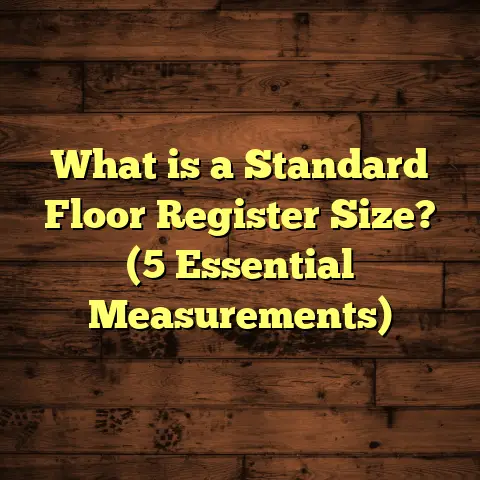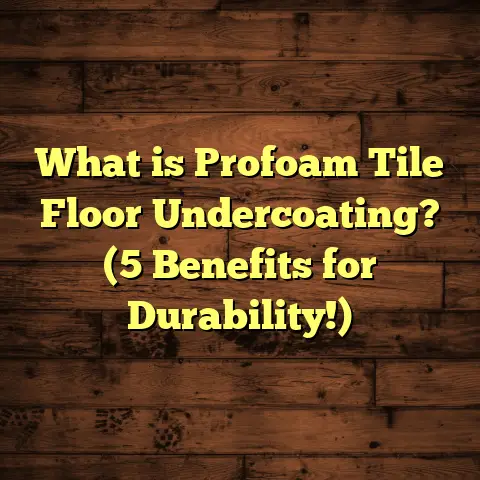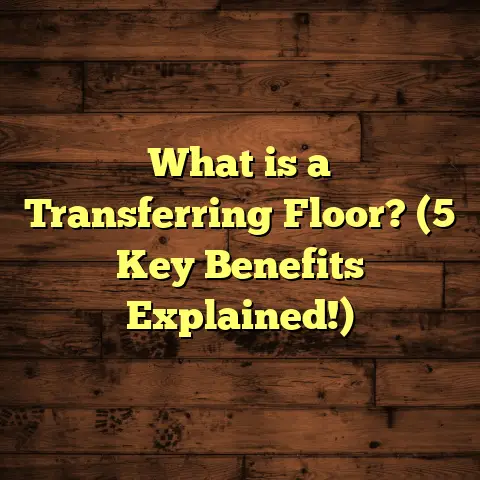What is Laminate Timber Flooring? (5 Key Benefits Explained)
Embracing Health with Laminate Timber Flooring
I’ve spent years working closely with homeowners, contractors, and designers, and one thing that never gets old is hearing how flooring choices can impact health. When I first started installing floors, it surprised me just how much the floor beneath our feet can affect the air we breathe inside. Carpets, for example, can trap dust mites, pollen, pet dander, and mold spores. These allergens can silently worsen respiratory issues or create discomfort for allergy sufferers.
Laminate timber flooring offers a much cleaner alternative. Its hard surface doesn’t allow dust or allergens to embed like carpet fibers do. Dust and particles sit on top where they can be easily wiped or vacuumed away. I’ve witnessed families with children who have asthma experience fewer symptoms once they replaced their carpets with laminate timber floors. One client told me their home felt “lighter” and fresher—no exaggeration.
If you think about it, the floor is one of the biggest surfaces in a room. Yet it’s often overlooked when considering indoor air quality. Laminate timber flooring reduces dust accumulation, helps manage humidity better than carpet, and creates an environment less hospitable to mold growth. At the same time, it looks like beautiful wood and feels warm underfoot.
Here’s a quick question: Have you ever noticed how much dust collects on your carpet between cleanings? Or how some homes smell stale because of damp carpets? Laminate timber flooring helps solve those problems in a practical way.
What Is Laminate Timber Flooring?
Let’s start at the beginning—what exactly is laminate timber flooring?
Laminate timber flooring is a multi-layer synthetic flooring product designed to replicate the appearance of real hardwood floors at a lower cost and with enhanced durability. Unlike solid hardwood, which is made from single pieces of natural wood, laminate is constructed from several layers fused together through high-pressure processes.
Here’s what makes up a typical laminate floor plank:
- Wear Layer: This is a transparent, tough melamine resin layer on top that protects the floor from scratches, stains, and fading caused by sunlight. It’s what keeps the floor looking new after heavy use.
- Decorative Layer: Below the wear layer is a photographic applique layer—a high-resolution image printed to mimic the look of natural wood grains and textures. This layer creates the authentic wood-like appearance.
- Core Layer: The heart of the plank is usually made from high-density fiberboard (HDF) or medium-density fiberboard (MDF). This core provides rigidity and impact resistance. HDF cores are denser and more durable than MDF.
- Backing Layer: On the underside, there’s a backing layer that balances the plank and adds moisture resistance from below.
The manufacturing process involves bonding these layers under heat and pressure to create strong, stable planks that look like hardwood but come with several advantages.
When I show clients sample laminate planks beside real hardwood samples, many can hardly tell the difference at first glance. Some laminates even have embossed or textured surfaces that simulate the feel of real wood grain.
Laminate comes in a variety of widths and lengths, styles, colors, and finishes—from light maple to dark walnut to distressed oak. This makes it versatile enough for modern urban flats or traditional country homes.
1. Affordability That Doesn’t Skimp on Style
One of the first reasons I recommend laminate timber flooring is its affordability without sacrificing aesthetic appeal.
Hardwood floors can be stunning but often come with sticker shock. Materials alone range roughly between $8 and $15 per square foot depending on wood species and quality. Installation adds another $4 to $8 per square foot due to specialized labor like sanding and finishing on-site.
Laminate flooring typically costs between $2 and $5 per square foot for materials. Installation is simpler since planks come pre-finished with click-lock systems that don’t require glue or nails. This reduces labor costs significantly—sometimes down to $1–$3 per square foot if you hire a pro.
To put this in perspective: For a 1,000-square-foot area, hardwood materials + installation might run $12,000–$23,000, whereas laminate could be $3,000–$8,000 total.
What surprises many is how realistic laminate floors look despite being synthetic. Advances in printing technology allow manufacturers to reproduce every tiny wood knot or grain line with precision. Plus, textures embossed into the surface add a tactile dimension.
I recall a couple who wanted an oak floor but had a tight budget after renovating their kitchen. We chose a high-quality laminate plank with an oak look featuring a textured surface. They were thrilled because it looked so authentic they had several guests ask if it was real wood.
This cost-effectiveness makes laminate timber flooring accessible to more people who want style without breaking the bank.
Personal Anecdote: The Budget-Friendly Renovation
Once, I helped a young family renovate their rental property to boost its market appeal. They wanted a wood-look floor but couldn’t afford hardwood across 1,200 square feet. We went with laminate timber flooring instead. The property rented within days of listing, and they reported saving thousands upfront without compromising style or durability.
2. Durability That Stands Up to Life’s Wear and Tear
I often ask homeowners: How much traffic do your floors see? Do you have kids or pets? Are you worried about scratches or dents?
These questions matter because durability varies widely across flooring types.
Laminate timber flooring is designed for resilience. Thanks to its tough melamine resin wear layer on top, it resists scratches from furniture movement, pet claws, and everyday activity better than many hardwood species.
The industry uses an Abrasion Criteria (AC) rating system to quantify durability:
- AC1: Light residential use (bedrooms)
- AC2: Moderate residential use (living rooms)
- AC3: Heavy residential / light commercial use (kitchens, hallways)
- AC4: General commercial use (offices)
- AC5: Heavy commercial use (public buildings)
For homes with kids or pets, I recommend at least AC3 rated laminate floors to ensure longevity.
In my experience installing floors in family homes, I’ve seen laminate last well over 15 years with minimal signs of wear—even in busy areas like entryways and kitchens.
One memorable project involved a family with two energetic dogs who scratched up previous hardwood floors badly. We installed an AC4-rated laminate floor with a textured surface that camouflaged scratches well. After five years, their floor still looked great despite all the activity.
Data Insight: Scratch Resistance
According to manufacturer testing data from Pergo—a leading laminate brand—AC3-rated floors withstand at least 2,500 revolutions in standardized abrasion tests before showing visible wear. AC5 floors endure over 6,000 revolutions.
This means laminate floors can handle daily life without losing their good looks quickly—a big plus if you want your investment to last.
3. Easy Maintenance for Busy Lifestyles
If you’re like most people I work with, your time is valuable. That’s why easy maintenance matters so much.
Laminate timber flooring requires very little upkeep compared to carpets or hardwood.
Simple routines like sweeping or dry mopping regularly keep dust and grit off the surface—this prevents scratches too. For deeper cleaning, a damp mop with water or specially formulated laminate cleaners works well.
Avoid soaking the floor; excess water can seep between joints if not sealed properly. But overall, no waxing or refinishing is needed like hardwood demands every few years.
I remember one client telling me they hated how their old carpet held pet odors and required professional cleaning multiple times yearly. After switching to laminate timber flooring, they said cleaning became “a five-minute job.”
Another benefit? Laminate floors don’t trap allergens like dust mites or pet dander as carpets do. If you have allergy sufferers at home, this can improve overall comfort significantly.
Quick Tip: Cleaning Routine
- Sweep daily or vacuum using a hard floor setting.
- Use a damp (not wet) mop weekly.
- Wipe spills immediately.
- Avoid abrasive cleaners or wax-based products.
With this simple care plan, laminate floors keep their shine and freshness for years without hassle.
4. Moisture Resistance That Protects Your Investment
Moisture has always been laminate flooring’s tricky point compared to vinyl or tile.
Traditional laminates aren’t fully waterproof because their core layers absorb water causing swelling or warping if exposed too long.
However, recent innovations have brought water-resistant and waterproof laminates that handle moisture much better than before.
Some manufacturers add waterproof coatings on top and seal edges carefully. Others use specially treated cores that resist swelling even when exposed to spills or humid conditions common in kitchens and basements.
I’ve installed these newer laminates in bathrooms and laundry rooms where water exposure risk is higher—and they’ve performed impressively over time.
Still, standing water should be cleaned up quickly regardless of flooring type to avoid damage.
Case Study: Basement Remodel
A homeowner wanted to finish their basement but worried about dampness damaging hardwood floors. We installed waterproof laminate timber flooring designed for below-grade use plus vapor barriers underneath.
Two years later they reported no swelling or warping even after heavy rains caused some minor flooding outside—proof modern laminates can handle moisture challenges when installed correctly.
5. Installation Flexibility: DIY Friendly and Fast
One reason I love recommending laminate timber flooring is how approachable installation can be for DIY enthusiasts.
Most laminate comes with “floating floor” systems where planks click together without glue or nails. This speeds up installation dramatically compared to hardwood that requires nailing and sanding on site.
You simply lay down an underlayment foam pad for cushioning and sound insulation over your subfloor (usually plywood or concrete), then snap planks together row by row until complete.
I’ve helped clients install their own laminate floors over weekends—and they were proud of their work afterward!
Floating floors also have the advantage of being removable if needed without damage underneath.
Tips for Successful DIY Installation
- Acclimate planks in room temperature for 48 hours before installation.
- Use spacers along walls to maintain expansion gaps.
- Cut planks carefully with saws designed for laminate.
- Work left to right in rows.
- Check alignment frequently for tight seams.
- Use transition strips where needed between rooms or flooring types.
This ease of installation reduces labor costs if hiring professionals isn’t an option and empowers homeowners who enjoy hands-on projects.
The Environmental Angle: Why Laminate Timber Flooring Can Be a Greener Choice
You might wonder about sustainability when choosing synthetic flooring instead of natural hardwood trees.
Here’s some good news: Many laminate manufacturers now prioritize eco-friendly practices:
- Using recycled wood fibers and materials in HDF cores.
- Employing low-VOC (volatile organic compound) adhesives and finishes.
- Participating in certification programs like FloorScore for indoor air quality.
- Producing durable floors that last long—reducing waste from replacements.
Compared to solid hardwood that sometimes involves cutting old-growth trees or exotic woods transported long distances, laminate can offer a lower environmental footprint when sourced responsibly.
In my conversations with eco-conscious clients, this aspect often helps them decide on laminate timber flooring confidently.
Addressing Common Concerns About Laminate Flooring
Even though I’m enthusiastic about laminate timber floors, I want to be honest about some common concerns I hear:
Q: Does laminate feel cold or hard underfoot?
A: It depends on underlayment choice. Using cushioned foam pads adds warmth and softness similar to hardwood with rugs beneath feet as well.
Q: Can laminate be refinished?
A: No—unlike hardwood which can be sanded multiple times, once a laminate floor wears out it must be replaced. However, modern laminates last long enough that this isn’t usually necessary for many years.
Q: What about noise from footsteps?
A: Proper underlayment reduces impact noise significantly. Also consider rugs in high traffic zones if needed.
Q: Will it fade in sunlight?
A: Quality laminates have UV inhibitors in the wear layer; fading is minimal under typical home conditions.
Comparing Laminate Timber Flooring With Other Popular Options
I’m often asked how laminate stacks up against hardwood, engineered wood, vinyl plank, tile, or carpet:
| Flooring Type | Cost per Sq Ft | Durability | Maintenance | Moisture Resistance | Installation Complexity | Appearance |
|---|---|---|---|---|---|---|
| Hardwood | $8-$15 | High (can scratch) | Moderate (refinish) | Low | High | Natural wood grain |
| Engineered Wood | $6-$12 | Moderate | Moderate | Moderate | Moderate | Wood veneer over plywood |
| Laminate Timber | $2-$5 | High (scratch resistant) | Low | Moderate (water-resistant options available) | Low (DIY-friendly) | Realistic wood look |
| Vinyl Plank | $2-$7 | Very High | Very Low | Excellent | Low | Wood/plank patterns |
| Carpet | $1-$5 | Low (wears quickly) | High (cleaning) | Poor | Moderate | Soft texture |
This table helps clients weigh pros and cons based on lifestyle needs like budget constraints, durability requirements, moisture levels in rooms, and installation preferences.
How I Help Clients Choose the Right Laminate Timber Floor
Over time I’ve developed a step-by-step approach when helping clients select laminate flooring:
- Assess Usage: Identify rooms with heavy foot traffic or moisture exposure.
- Set Budget: Determine material + installation budget upfront.
- Choose Style: Select wood species look & finish (matte vs glossy).
- Check Durability: Pick AC rating based on lifestyle needs.
- Consider Installation: Decide if DIY or professional install.
- Test Samples: View planks in home lighting; feel texture.
- Plan Maintenance: Discuss care routines & cleaning products.
- Confirm Warranty: Review manufacturer guarantees for peace of mind.
This process saves time during decision-making while ensuring satisfaction with end results.
Final Thoughts From My Flooring Journeys
If I were to summarize why I’m passionate about laminate timber flooring after all these years working hands-on with it—it’s this:
It offers beautiful wood aesthetics combined with affordability and practicality few other options match. It supports healthier homes through easier allergen control and simple maintenance routines fit for busy lives. Plus modern innovations make it tougher against moisture while remaining accessible for DIY installations.
Every floor tells a story—of families growing up together, pets running freely without fear of damage, homeowners gaining confidence knowing their investment will last years without constant upkeep. I’ve seen all these stories unfold beneath my hands installing laminate timber floors across different homes, climates, and budgets—and it never gets old helping people find the perfect fit for their lifestyle.
If you’re weighing your options right now—ask yourself some honest questions about what matters most for your space:
- How important is appearance versus cost?
- Do allergies affect someone at home?
- What kind of traffic do your floors see?
- Will you install yourself or hire help?
- Is moisture exposure a concern?
Answering these will guide you toward whether laminate timber flooring could be right for you—and if so, which products suit best.
Feel free to reach out anytime if you want personalized advice based on your unique project—I’m always happy to share practical tips from my years in this trade!
(End of article)





